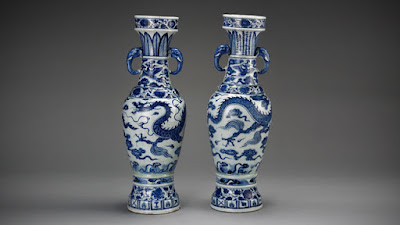Chinese Art Heist Shocks Norway Objects Heading to China?
Chinese Art Heist Shocks Norway | The Secret History of Art | ARTINFO.com
On Saturday, 5 January, 23 rare Chinese artifacts and artworks were stolen in a daring heist at the Bergens Industrial Arts Museum in Norway. Once home to one of Europe’s largest collections of Chinese art, the private collection of a Norwegian general who fought with the Chinese Imperial Army, the theft has shocked Norway, and is strangely reminiscent of a pair of heists of Chinese art in Cambridge and Durham, England last year, as well as another theft, of 53 Chinese artifacts, from the same museum two years ago—suggesting that the same criminal group may be involved. The entire theft took just 90 seconds, and can be viewed here.
The Secret History of Art was interviewed for a Norwegian national newspaper, and the Q&A is reproduced here.
** Since the raids in Bergen are so similar to those in the UK, do you believe that the stolen artifacts are headed to China right now? If so, why?
I would guess that the artifacts are en route to China. There is a specific niche market for Chinese artifacts, unlike other periods and styles, like Impressionist painting or Old Masters, which have broad general appeal. Western collectors of Chinese art are a small, passionate group, but the greatest value for Chinese art is among the nouveau riche in China. China is also an unusual case study. Chinese laws on everything from theft to Intellectual Properties are very different from those in the West, and therefore stolen or forged artworks find a market far more easily there than abroad. A certain type of Chinese collector would be far less shy about purchasing a knowingly stolen artwork than a Western collector would. Chinese collectors could purchase stolen Chinese art and still have the pride of display, perhaps with the rationale that, whether or not the object was stolen, it should be in China, and therefore the collector was somehow aiding its liberation. This rationale does not function among Western collectors, but sometimes can in China.
On Saturday, 5 January, 23 rare Chinese artifacts and artworks were stolen in a daring heist at the Bergens Industrial Arts Museum in Norway. Once home to one of Europe’s largest collections of Chinese art, the private collection of a Norwegian general who fought with the Chinese Imperial Army, the theft has shocked Norway, and is strangely reminiscent of a pair of heists of Chinese art in Cambridge and Durham, England last year, as well as another theft, of 53 Chinese artifacts, from the same museum two years ago—suggesting that the same criminal group may be involved. The entire theft took just 90 seconds, and can be viewed here.
The Secret History of Art was interviewed for a Norwegian national newspaper, and the Q&A is reproduced here.
** Since the raids in Bergen are so similar to those in the UK, do you believe that the stolen artifacts are headed to China right now? If so, why?
I would guess that the artifacts are en route to China. There is a specific niche market for Chinese artifacts, unlike other periods and styles, like Impressionist painting or Old Masters, which have broad general appeal. Western collectors of Chinese art are a small, passionate group, but the greatest value for Chinese art is among the nouveau riche in China. China is also an unusual case study. Chinese laws on everything from theft to Intellectual Properties are very different from those in the West, and therefore stolen or forged artworks find a market far more easily there than abroad. A certain type of Chinese collector would be far less shy about purchasing a knowingly stolen artwork than a Western collector would. Chinese collectors could purchase stolen Chinese art and still have the pride of display, perhaps with the rationale that, whether or not the object was stolen, it should be in China, and therefore the collector was somehow aiding its liberation. This rationale does not function among Western collectors, but sometimes can in China.



Comments
Post a Comment
If you have any questions or comments please send us a message. Or use the Contact Us tab at the top of the page.